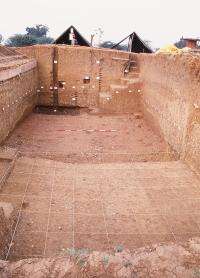Stone cutting tools link early humans to prehistoric India

Dating of recently discovered artifacts in South India indicates that early humans lived in the region more than a million years ago, and that they used distinct 'Acheulian' stone cutting tools, a new study reports in journal Science.
Acheulian tools originated in Africa around 1.5 million years ago and are thought to have spread throughout Eurasia.
The exact chronology of this spread, however, has been a longstanding puzzle. Knowing how old the oval and pear-shaped hand axes, cleavers and other artifacts are will help archeologists understand early human migration into South Asia and the Indonesian archipelago.
The artifacts were discovered in one of the richest Paleolithic sites in Tamil Nadu, India, called Attirampakkam. Nestled in the Kortallayar river basin, the site was discovered in 1863 by British geologist Robert Bruce Foote, and has been excavated (off and on) since then.
Shanti Pappu and colleagues determined the ages of these tools, which suggest that Acheulian tool-making humans were present in South Asia around a million years ago or earlier, existing at the same time as other populations in southwest Asia and Africa.
The team discovered more than 3,500 quartzite stone artifacts, including more than 70 Acheulian hand axes, cleavers and flakes (small chipped stones).
By taking paelomagnetic measurements, the researchers were able to directly date the sediments that covered the Acheulian tools. All paleomagnetic measurements from around the site showed a reversed polarity, meaning that the sediment predates the period after the last reversal of Earth’s magnetic field.
The discovery of reverse polarity establishes the fact that the sediments are more than a million years old.
To obtain an even more precise age of the artifacts, the researchers applied a burial dating technique that measures isotopes of two earth metals, aluminum and beryllium.
The findings hint that early humans with distinctive tools migrated throughout Eurasia over a million years ago.
A related Perspective outlines the paper’s major findings and discusses how this new evidence affects scientists understanding of the South Asian Acheulian.
More information: "Early Pleistocene Presence of Acheulian Hominins in South India," by S. Pappu et al., Science (2011).
Provided by AAAS


















